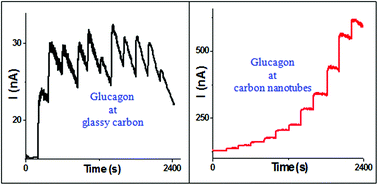Hormone glucagon: electrooxidation and determination at carbon nanotubes
Abstract
The oxidation of glucagon, which is one of the key hormones in glucose homeostasis, was studied at electrodes modified with carbon nanotubes (CNT) that were dispersed in a polysaccharide adhesive chitosan (CHIT). Such electrodes displayed improved resistance to fouling, which allowed for the investigation of both the electrolysis/mass spectrometry and electroanalysis of glucagon. The off-line electrospray ionization and tandem mass spectrometric analyses showed that the −4 Da mass change to glucagon upon electrolysis at CNT was due to the electrooxidation of its tryptophan (W25) and dityrosine (Y10, Y13) residues. The methionine residue of glucagon did not contribute to its oxidation. The amperometric determination of glucagon yielded the limit of detection equal to ∼20 nM (E = 0.800 V, pH 7.40, S/N = 3), sensitivity of 0.46 A M−1 cm−2, linear dynamic range up to 2.0 μM (R2 = 0.998), response time <5 s, and good signal stability. Free tryptophan and tyrosine yielded comparable analytical figures of merit. The direct amperometric determination of unlabeled glucagon at CHIT–CNT electrodes is the first example of a rapid alternative to the complex analytical assays of this peptide.


 Please wait while we load your content...
Please wait while we load your content...